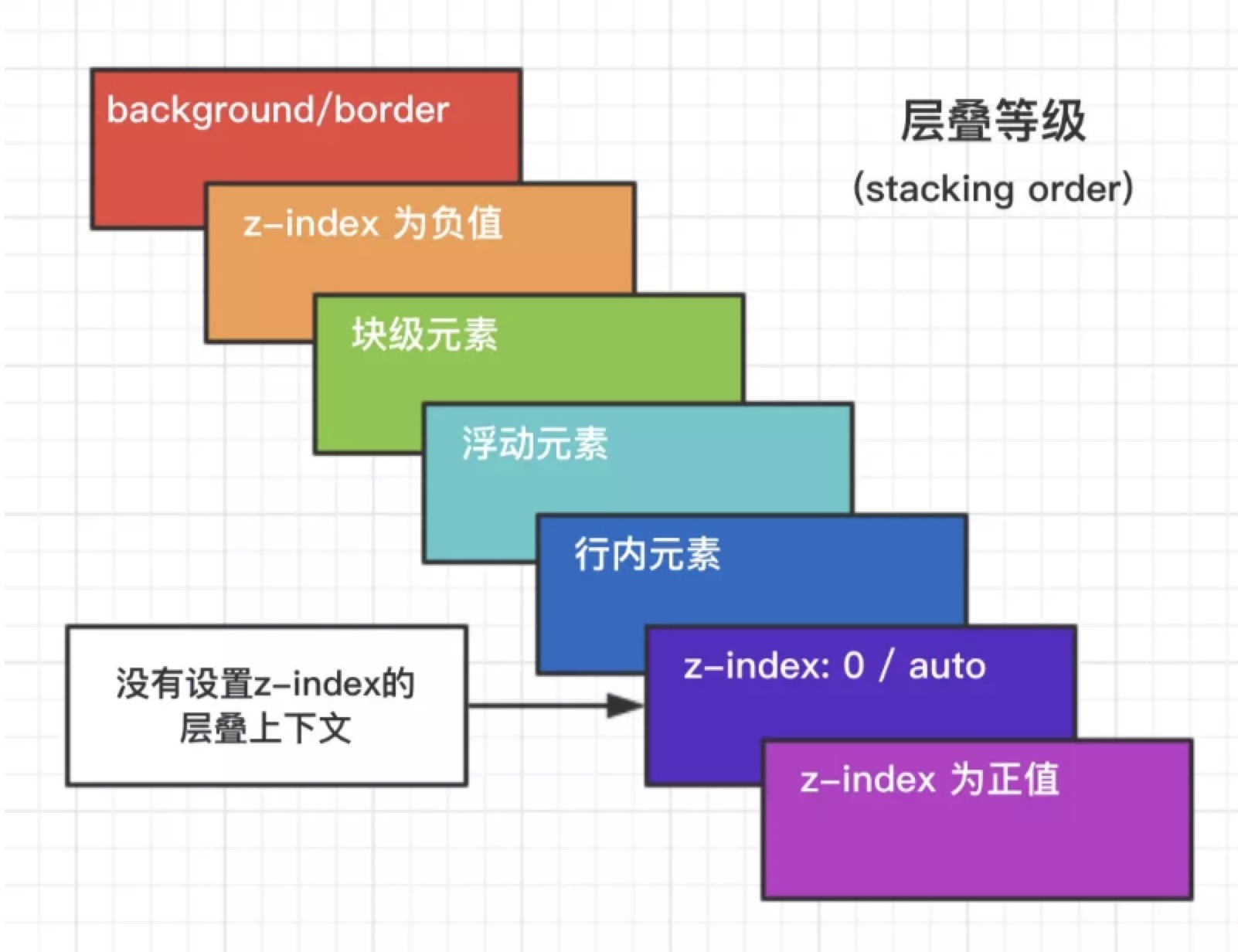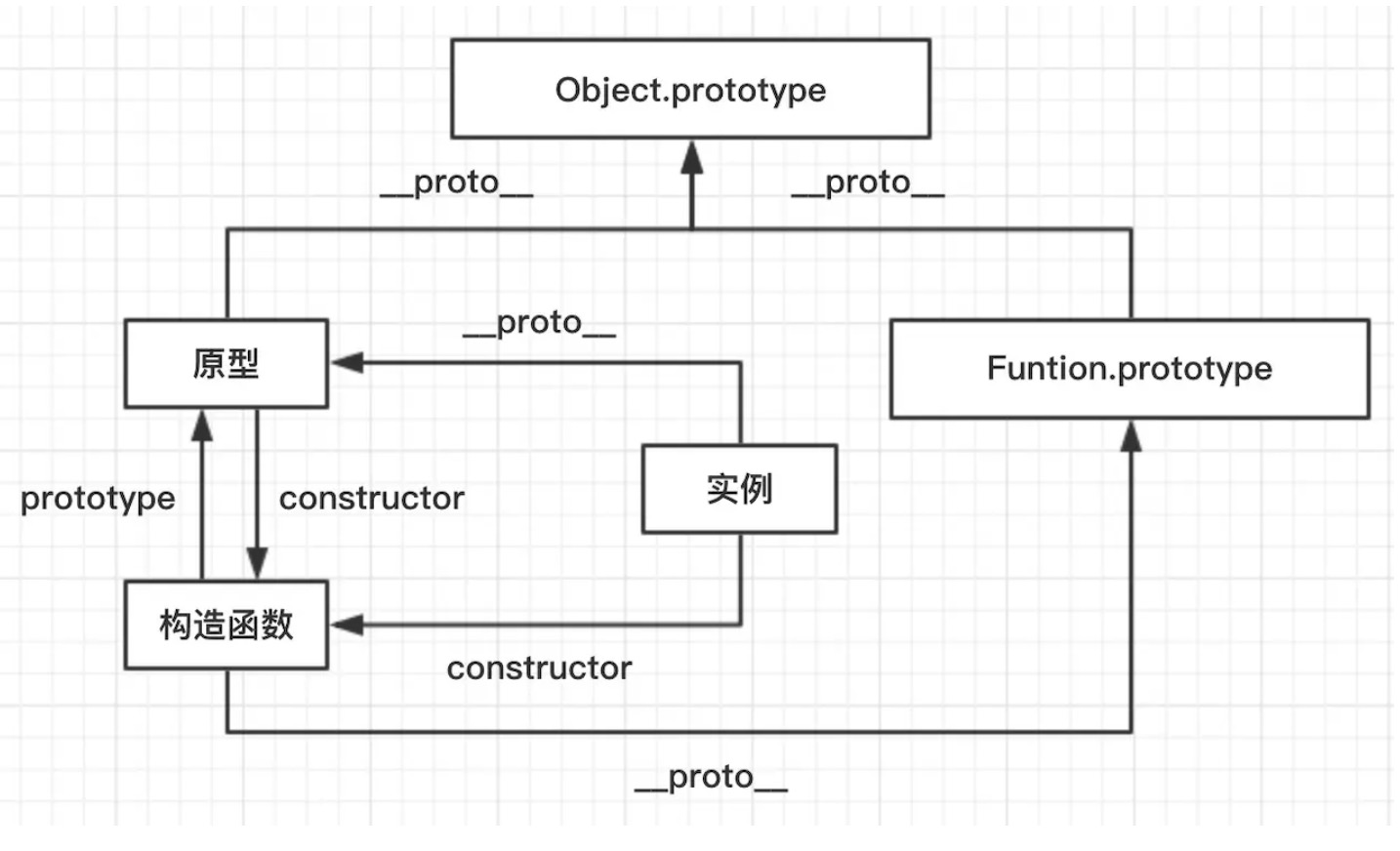# CSS
# 行内元素和块级元素有什么区别
行内元素指的是书写完成后不会自动换行,并且元素没有宽和高,margin padding无效。 块级元素写完后会自动换行,有宽高可以修改。 行内元素可以display:inline-block;变成行内块元素 可以设置宽高 margin padding
块级元素有:address article aside audio blockquote dd div dl fieldset figcaption figure footer form h1-h6 header bgroup hr noscript ol output p section canvas table tfoot ul video
行内元素有:b, big, i, small, tt abbr, acronym, cite, code, dfn, em, kbd, strong, samp, var a, bdo, br, img, map, object, q, script, span, sub, sup button, input, label, select, textarea
# 盒子模型
dom采用的布局模型,可以通过box-sizing进行设置 1、content-box (w3c标准盒模型) width 与 height 只包括内容的宽和高,不包括边框(border),内边距(padding),外边距(margin)。 2、border-box (ie盒模型) width = border + padding + 内容的宽度 3、padding-box padding计算入width内 只有Firefox实现了这个值,它在Firefox 50中被删除。 4、margin-box (浏览器未实现)
# 层叠上下文
关于will-changge cpu gpu 硬件加速问题 https://www.w3cplus.com/css3/introduction-css-will-change-property.html
元素提升为一个比较特殊的图层,在三维空间中 (z轴) 高出普通元素一等。
触发条件:
1、根层叠上下文(html)
2、position
3、css属性 flex、transform、opacity、will-change、overflow-scroll
层叠等级 
# 水平居中、垂直居中、水平垂直居中
# 选择器优先级
!important > 行内样式 > #id > .class > tag > * > 继承 > 默认 选择器从右往左解析
# 清除浮动
额外标签、伪类元素、bfc overflow:hidden、父元素也设置浮动
# link和@inmport区别
1、link功能较多,可以定义rss,定义rel等作用,而@import只能用于加载css 2、当解析到link时,页面会同步加载css,@import所引用的css会等到页面加载完才能加载 3、@import需要ie5以上才能使用 4、link可以js动态引用,@import不行
# JS
# js
function Foo() {
getName = function () { alert (1); };
return this;
}
Foo.getName = function () { alert (2);};
Foo.prototype.getName = function () { alert (3);};
var getName = function () { alert (4);};
function getName() { alert (5);}
//答案:
Foo.getName();//2
getName();//4
Foo().getName();//1
getName();//1
new Foo.getName();//2
new Foo().getName();//3
new new Foo().getName();//3
2
3
4
5
6
7
8
9
10
11
12
13
14
15
16
17
------ 第二问 ------
function Foo() {
getName = function () { alert (1); };
return this;
}
var getName;//只提升变量声明
function getName() { alert (5);}//提升函数声明,覆盖var的声明
Foo.getName = function () { alert (2);};
Foo.prototype.getName = function () { alert (3);};
getName = function () { alert (4);};//最终的赋值再次覆盖function getName声明
getName();//最终输出4
2
3
4
5
6
7
8
9
10
11
12
------ 第三问 ------ 第三问的 Foo().getName(); 先执行了Foo函数,然后调用Foo函数的返回值对象的getName属性函数。 Foo函数的第一句 getName = function () { alert (1); }; 是一句函数赋值语句,注意它没有var声明,所以先向当前Foo函数作用域内寻找getName变量,没有。再向当前函数作用域上层,即外层作用域内寻找是否含有getName变量,找到了,也就是第二问中的alert(4)函数,将此变量的值赋值为 function(){alert(1)}。
此处实际上是将外层作用域内的getName函数修改了。 注意:此处若依然没有找到会一直向上查找到window对象,若window对象中也没有getName属性,就在window对象中创建一个getName变量。 之后Foo函数的返回值是this,而JS的this问题博客园中已经有非常多的文章介绍,这里不再多说。 简单的讲,this的指向是由所在函数的调用方式决定的。而此处的直接调用方式,this指向window对象。 遂Foo函数返回的是window对象,相当于执行 window.getName() ,而window中的getName已经被修改为alert(1),所以最终会输出1 此处考察了两个知识点,一个是变量作用域问题,一个是this指向问题。
------ 第四问 ------ 直接调用getName函数,相当于 window.getName() ,因为这个变量已经被Foo函数执行时修改了,遂结果与第三问相同,为1
------ 第五问 ------ new Foo.getName(); ,此处考察的是js的运算符优先级问题。 https://developer.mozilla.org/zh-CN/docs/Web/JavaScript/Reference/Operators/Operator_Precedence 通过查上表可以得知点(.)的优先级高于new操作,遂相当于是:
new (Foo.getName)();
所以实际上将getName函数作为了构造函数来执行,遂弹出2。
------ 第六问 ------ new Foo().getName() ,首先看运算符优先级括号高于new,实际执行为 (new Foo()).getName() 遂先执行Foo函数,而Foo此时作为构造函数却有返回值,所以这里需要说明下js中的构造函数返回值问题。 构造函数的返回值 在传统语言中,构造函数不应该有返回值,实际执行的返回值就是此构造函数的实例化对象。 而在js中构造函数可以有返回值也可以没有。 1、没有返回值则按照其他语言一样返回实例化对象
function F() {}
//undefined
new F()
//F{}
2
3
4
2、若有返回值则检查其返回值是否为引用类型。如果是非引用类型,如基本类型(string,number,boolean,null,undefined)则与无返回值相同,实际返回其实例化对象。
function F() {return ture}
//undefined
new F()
//F{}
2
3
4
3、若返回值是引用类型,则实际返回值为这个引用类型。
function F() {return {a:1}}
//undefined
new F()
//Object {a:!}
2
3
4
原题中,返回的是this,而this在构造函数中本来就代表当前实例化对象,遂最终Foo函数返回实例化对象。 之后调用实例化对象的getName函数,因为在Foo构造函数中没有为实例化对象添加任何属性,遂到当前对象的原型对象(prototype)中寻找getName,找到了。 遂最终输出3。
------ 第七问 ------ new new Foo().getName(); 同样是运算符优先级问题。 最终实际执行为: new ((new Foo()).getName)(); 先初始化Foo的实例化对象,然后将其原型上的getName函数作为构造函数再次new。 遂最终结果为3
# 用js实现随机选取10–100之间的10个且不重复的数字,存入一个数组。还要排序
let numS=new Set();
while (numS.size<10) {
numS.add(parseInt(10 + Math.random() * 90));
}
console.log([...numS].sort((a,b)=>a-b));
2
3
4
5
# 请写出弹出值,并解释为什么
alert(a) //ƒ a() {console.log(10)}
a();
var a = 3;
function a() {
alert(10) //10
}
alert(a) //3
a = 6;
a();//Uncaught TypeError: a is not a function
2
3
4
5
6
7
8
9
# 请写出如下输出值,并写出把注释掉的代码取消注释的值,并解释为什么
var a = function people(num) {
people = num;
console.log(typeof people);//function
}
a(1)
var a = function people(num) {
people = num;
console.log(typeof people);//function
}
a(1);
console.log(typeof people())//people is not defined
2
3
4
5
6
7
8
9
10
11
12
这种函数表达式,people()只读只能内部访问
let fn = {
a:function() {
console.log(1);
},
b() {
console.log(2);
},
c:()=>{
console.log(3);
}
}
var n1 = new fn.a();
var n2 = new fn.b();//报错
fn.c()
2
3
4
5
6
7
8
9
10
11
12
13
14
es6写法的不允许被new
var s = {
a: function () {
console.log(this);//a{}
}
}
var f = s.a.bind(this);
new f();
var s = {
a: function () {
console.log(this);//window{}
}
}
var f = s.a.bind(this);
f();
2
3
4
5
6
7
8
9
10
11
12
13
14
15
16
17
new过后bind没乱用,new过后this变成函数的实例
this.a = 20;
var test = {
a: 40,
init: () => {
console.log(this.a);
function go() {
// this.a = 60;
console.log(this.a);
}
go.prototype.a = 50;
return go;
}
};
//var p = test.init();
//p();
new (test.init())();
2
3
4
5
6
7
8
9
10
11
12
13
14
15
16
# 请写出以下代码执行结果
function C1(name) {
if (name) this.name = name;
}
function C2(name) {
this.name = name;
}
function C3(name) {
this.name = name || 'fe';
}
C1.prototype.name = "yideng";
C2.prototype.name = "lao";
C3.prototype.name = "yuan";
console.log((new C1().name) + (new C2().name) + (new C3().name));
2
3
4
5
6
7
8
9
10
11
12
13
function test(a) {
this.a = a;//选择是否注释看效果
}
test.prototype.a = 3;
test.prototype.init = function () {
console.log(this.a);//3
}
var s = new test();
s.init()
2
3
4
5
6
7
8
9
# 对象和闭包不能在一起 必须有分号
var obj = {
name:'xiao'
}
(function() {
console.log('haha');
}())
2
3
4
5
6
# 请写出如下点击li的输出值,并用三种办法正确输出li里的数字
<ul>
<li>1</li>
<li>2</li>
<li>3</li>
<li>4</li>
<li>5</li>
<li>6</li>
</ul>
var liList = document.getElementsByTagName('li');
for (var i = 0; i < liList.length; i++) {
liList[i].onclick = (function () {
var index = i;
// 返回了一个匿名函数
return function () {
console.log('我的索引是:' + index);
};
}())
// liList[i].onclick = function() {
// console.log(this.innerHTML);
// }
}
2
3
4
5
6
7
8
9
10
11
12
13
14
15
16
17
18
19
20
21
22
# 写出输出值,并解释为什么
考察点 按值传递 按引用传递
function test(m) {
m = { v: 5 }
}
var m = { k: 30 };
test(m);
alert(m.v);//undefined
**函数参数是按值传递的**
2
3
4
5
6
7
8
# 请写出代码执行结果,并解释为什么
function yideng() {
console.log(1);
}
(function () {
if (false) {
function yideng() {
console.log(2);
}
}
console.log(typeof yideng) //undefined
yideng();
})();
2
3
4
5
6
7
8
9
10
11
12
分3种情况 ie 老版本浏览 器整个函数体提升 function yideng() {console.log(2)} 现在版本浏览器 函数名提升 yideng
[,,]// 求它的长度 不同浏览器长度不同
# es5、es6的继承
es5
function Person(color) {
this.color = color;
}
Person.prototype.say = function () {
console.log('Hello world!');
}
function chinese(color) {
Person.call(this, color)
}
var __prototype = Object.create(Person.prototype);
__prototype.constructor = chinese;
chinese.prototype = __prototype;
chinese.prototype.kungfu = function () {
console.log('yongchun!');
}
var xiaoming = new chinese('yellow');
console.log(xiaoming);
2
3
4
5
6
7
8
9
10
11
12
13
14
15
16
17
18
19
20
es6
class Person {
constructor(color) {
this.color = color;
}
say() {
console.log(this.color);
}
}
class chinese extends Person {
constructor(color) {
super(color)
}
kungfu() {
console.log('yongchun!');
}
}
let xiaoming = new chinese('yellow');
console.log(xiaoming.say());
console.log(xiaoming);
2
3
4
5
6
7
8
9
10
11
12
13
14
15
16
17
18
19
20
21
# 写出如下代码执行结果,并解释为什么
function fn() {
console.log(this.length);
}
var person = {
length: 5,
method: function (fn) {
fn()
}
};
person.method(fn, 1)
2
3
4
5
6
7
8
9
10
window.length输出的iframe的个数
function fn() {
console.log(this);//arguments
console.log(this.length);//2
}
var person = {
length: 5,
method: function (fn) {
// fn()
console.log(arguments[0]);//fn(){}
arguments[0]();
}
};
person.method(fn, 1)
2
3
4
5
6
7
8
9
10
11
12
13
# 手写bind
https://blog.csdn.net/u010552788/article/details/50850453
if (!Function.prototype.bind) {
Function.prototype.bind = function (oThis) {
if (typeof this !== 'function') {
throw new TypeError('Function.prototype.bind - what is trying to be bound is not callable');
}
var aArgs = Array.prototype.slice.call(arguments, 1),
fToBind = this,
fNOP = function () { },
fBound = function () {
// this instanceof fBound === true时,说明返回的fBound被当做new的构造函数调用
return fToBind.apply(this instanceof fBound
? this
: oThis,
// 获取调用时(fBound)的传参.bind 返回的函数入参往往是这么传递的
aArgs.concat(Array.prototype.slice.call(arguments)));
};
// 维护原型关系
if (this.prototype) {
// Function.prototype doesn't have a prototype property
fNOP.prototype = this.prototype;
}
// 下行的代码使fBound.prototype是fNOP的实例,因此
// 返回的fBound若作为new的构造函数,new生成的新对象作为this传入fBound,新对象的__proto__就是fNOP的实例
fBound.prototype = new fNOP();
return fBound;
};
}
function foo() {
this.b = 100;
return this.a;
}
var func = foo.bind({ a: 1 })
func();//1
new func();//foo {b: 100}
2
3
4
5
6
7
8
9
10
11
12
13
14
15
16
17
18
19
20
21
22
23
24
25
26
27
28
29
30
31
32
33
34
35
36
37
38
39
# 如何找到数组最大值
const findMax = (arr) => (arr.reduce((prev, next) => next > prev ? next : prev));
# 给定一个大小为 n 的数组,找到其中的众数。众数是指在数组中出现次数大于 ⌊ n/2 ⌋ 的元素
let arr = [5, 2, 2, 3]
const majorityElement = arr => {
arr.sort((a, b) => a - b)
return Math.floor(arr.length / 2)
}
console.log(majorityElement(arr));
2
3
4
5
6
7
# 原型、构造函数、实例
原型 一个简单的对象,用来实现对象的继承。可以简单理解成对象的爹。在js中每个对象都包含一个__proto__的属性指向它的爹也就是原型。 构造函数 可以通过new来新建一个对象的函数 实例 通过通过函数和new创建出来的对象,便是实例。实例通过__proto__指向原型,通过constructor指向构造函数 实例.proto === 原型 构造函数.prototype === 原型 原型.constructor === 构造函数 实例.constructor === 构造函数

原型链 原型链是由原型对象组成,每个对象都有__proto__属性,指向了创建对象的构造函数的原型,_proto__将对象连接起来形成了原型链。是一个用来实现继承和共享属性的有限的对象链。
属性查找机制 当查找对象的属性时,如果实例对象自身不存在该属性,则沿着原型链往上一级查找,找到时则输出,不存在时,则继续沿着原型链往上一级查找,直至最顶层的原型对象Object.prototype,如果还没有找到,则输出undefined.
属性修改机制 只会修改实例对象本身的属性,如果不存在,则进行添加该属性,如果需要修改原型的属性时,则可以用:b.prototype.x = 2;但是这样会造成所有继承于该对象的实例的属性发生改变。
# js
var x = 1;
if (function f() { }) {//把f 放到()中,变成表达式立即执行 变成true 然后消失
x += typeof f
}
// console.log(x);//1undefined
2
3
4
5
# try catch
不会让try后面的代码终止,但是会让try里面的代码终止
try {
console.log('a')
console.log(b)
console.log('c')
} catch (error) { //error.name error.message
console.log('d')
console.log(error)
console.log(error.name);
}
console.log('e')
2
3
4
5
6
7
8
9
10
11
12
Error.name的六种值对应的信息 1、EvalError:eval()的使用与定义不一致 2、RangeError:数值越界 3、ReferenceError:非法或不能识别的引用数值 4、SyntaxError:发生语法解析错误 5、TypeError:操作数据类型错误 6、URIError:URL处理函数使用不当
# 克隆
浅克隆
- 传统
var obj = {
name:'xiaoming',
age:18,
male:'man',
card:['first','second']
}
var obj1 = {}
function clone(origin,target) {
var target = target || {};
for(var prop in origin) {
target[prop] = origin[prop]
}
return target;
}
clone(obj,obj1)
console.log(obj1);
2
3
4
5
6
7
8
9
10
11
12
13
14
15
16
17
18
- Object.assign()
- 展开运算符(...)
深克隆 1、判断是不是原始类型 2、判断是数组还是对象 3、建立相应的数组或对象
- 传统 递归进行逐一赋值
var obj = {
name: 'xiaoming',
age: 18,
male: 'man',
card: ['first', 'second'],
wife: {
name: 'abc',
son: {
name: 'def',
}
}
}
var obj1 = {}
function deepClone(origin, target) {
var target = target || {},
toStr = Object.prototype.toString,
arrStr = "[object Array]"
for (var prop in origin) {
if (origin.hasOwnProperty(prop)) {
if (origin[prop] !== 'null' && typeof (origin[prop]) == 'object') {
target[prop] = (toStr.call(origin[prop]) == arrStr ? [] : {})
deepClone(origin[prop], target[prop])
} else {
target[prop] = origin[prop]
}
}
}
return target
}
deepClone(obj, obj1)
2
3
4
5
6
7
8
9
10
11
12
13
14
15
16
17
18
19
20
21
22
23
24
25
26
27
28
29
30
31
32
- JSON.parse(JSON.stringify(obj)) 性能最快 具有循环引用的对象时报错 当为函数、undefined、symbol 无法拷贝
# js
var test = {
bar: function () {
return this.baz;
},
baz: 1
};
(function () {
console.log(arguments[0]());//bar() {} 这里打印看一下 this
console.log(typeof arguments[0]());//undefined
})(test.bar)
2
3
4
5
6
7
8
9
10
var x = [typeof x,typeof y][1];//y undefined
console.log(typeof x); //string
2
function f() {
return f;//如果是引用类型 return出去的就是实例
}
console.log(new f() instanceof f);//false
2
3
4
Object.prototype.a = '1';
Function.prototype.a = '2';
function Person() {};
var test = new Person();
console.log(test);
2
3
4
5
var test = [0];
if(test) {
console.log(test);//[0]
console.log(test == false);//true
}else{
console.log('fail');
}
2
3
4
5
6
7
<script>
test;//报错不往下执行
console.log(1);
</script>
<script>
console.log(2);//2
</script>
2
3
4
5
6
7
# js
console.log(a);
console.log(typeof yideng(a));
var flag = true;
if (!flag) {
var a = 1;
}
if (flag) {
function yideng(a) {
yideng = a;
console.log("yideng1");
}
} else {
function yideng(a) {
yideng = a;
console.log("yideng2");
}
}
2
3
4
5
6
7
8
9
10
11
12
13
14
15
16
17
# 根据tbl_id的值去重
let arr=[
{tbl_id: 1, tbl_name: 'tbl1'},
{tbl_id: 2, tbl_name: 'tbl2'},
{tbl_id: 2, tbl_name: 'tbl2'},
{tbl_id: 3, tbl_name: 'tbl3'}
];
const fn = (arr) => {
const obj = {};
arr.forEach(item => {
if (!obj[item['tbl_id']]) {
obj[item['tbl_id']] = item
}
});
console.log(Object.values(obj));
return Object.values(obj)
}
fn(arr)
2
3
4
5
6
7
8
9
10
11
12
13
14
15
16
17
18
19
← 面向切面 前端基础面试题(二) →